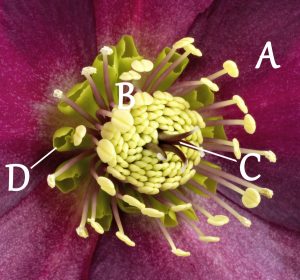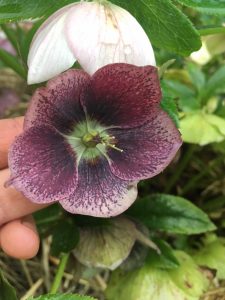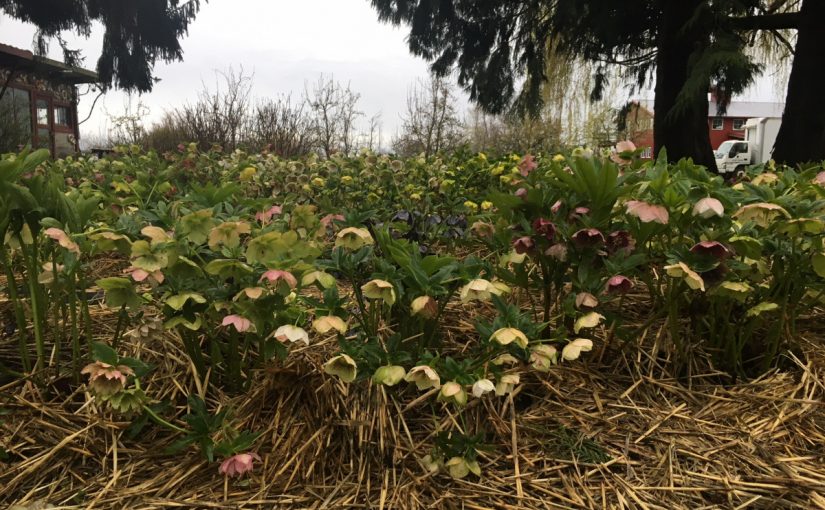Family: Ranunculaceae (also in this family: buttercup, ranunculus, anemone, nigella, delphinium, clematis, columbine). Members of the family are primarily herbaceous perennials, but a few are woody climbers or shrubs. For the most part, flowers in this family will be bisexual. Flowers may be solitary, but are often clustered in cymes, panicles, or spikes. The flowers are typically radially symmetrical but are strongly bilaterally symmetrical in the genera Aconitum and Delphinium (Zomlefer).
Subfamily: Helleboroideae
Genus: Helleborus, approximately 20 species of herbaceous or evergreen perennial flowering plants.
Helleborus species are differentiated based upon stemming and rhizome patterns.
“The caulescent (stemmed) species grow their rhizomes from the thickened lignified hypocotyl and the bottom part of the stem. The bottom stem branches by growing new shoots from axillary buds. These species produce secondary roots on the primary rots.” (Botany: Helleborus Gold Collection)
The stemmed species have clumps of numerous tall stems. Each stem will also grow several evergreen leaves. In early to mid-winter, racemes or clusters of flowers will bloom atop these stems. After the flowers are spent, the stem will never blossom again, in which case gardeners will cut back the stem to the ground after the flower is spent. (Information on the Genus Helleborus)
“In acaulescent (stemless) species, the primary root dies as the seedling develops into an adult plant. Each year, the plants produce new adventitious roots on the new rhizome side shoots. Old roots are thick, fleshy and often a brownish or blackish colour. This large difference between these two groups’ root system explains why only acaulescent species can be propagated by division.” (Botany: Helleborus Gold Collection)
Helleborus orientalis (also know as the Lenten rose) and hybrids of this species are common garden and cut-flower Hellebore. They are an acaulescent species. These species have basal leaves rather than leaves on their stems and the stems grow right up from the ground.

Photo: Botany-Helleborus Gold Collection
Hellebore flowers are unique in that the colorful flowers are actually made up of sepals rather than petals. Sepals are generally for protection. The Helleborus petals evolved overtime into nectaries (short, tubular flower organs producing nectar to attract the few and far between insects around in those early month of the year when Hellebores are blooming). The cool thing about Hellebores is that those beautiful sepals remain in tact until the seeds have matured (Botany: Helleborus Gold Collection).

There are no Helleborus native to the Americas, generally brought here from the British Isles, Europe, Asia Minor, and one species from China. They mostly grow on the periphery of slopping and well-drained deciduous woodland or in shaded clearings among scrub or rocks. They can also found on apparently open, sunny slopes which may later become overgrown and thus shaded in summer. Mostly found in limestone areas, but can thrive in both acid and alkaline soils (Information on the Genus Helleborus). According to Janet Loughrey in an article entitles Planting and Caring for Hellebores published in Garden Design Magazine:
- Zone: 4-9, evergreen 6-9
- Bloom Time: February-May
- Bloom Size: 2 to 3 1/2 inches
- Height/Spread: 18 to 24 inches/24 inches
- Site: Partial shade, well draining soil
- Type: Herbaceous perennial
- Seed Type: Dicotyledon
When harvesting, for longest vase life:
- Wait to harvest until after the hellebore have dropped their stamens and actual petals and it begins to form its seed pod. This is when hellebores hold up the best as cut flowers. Vase life is up to one week.
- If you want to harvest prior to this stage, before the flower is pollinated, methods like putting the stems in boiling water, slicing up the side of the stem, and/or putting the stems in a hydrating solution can all work to extend the vase life.
SOURCES:
Jello Mold Farm (Mount Vernon, WA)
3 Porch Farm (Comer, GA)
Plant and Caring for Hellebores, Janet Loughrey
Botany: Helleborus Gold Collection
Information on the Genus Helleborus
Guide to Flowering Plant Families, Wendy B. Zomlefer
Plant Families: A Guide for Gardeners and Botanists, Ross Bayton and Simon Maughan
